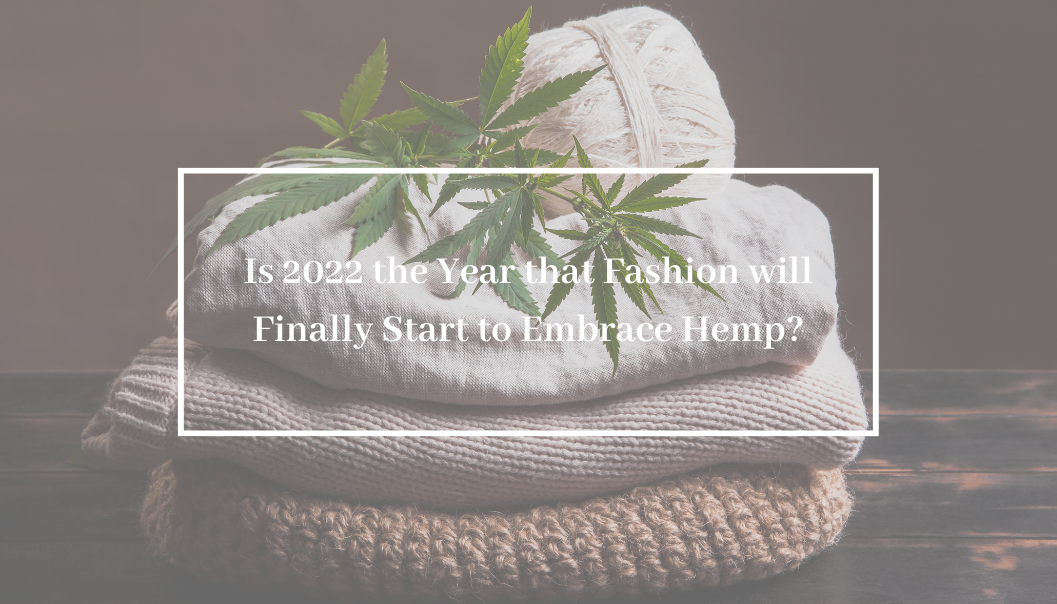
NEWS & PRESS
Is 2022 the Year that Fashion will Finally Start to Embrace Hemp?
Hemp farmers have had a tricky couple of years. When CBD boomed, lots of growers overestimated demand for their following year’s crops and invested really heavily. In 2019, many lost plants to pests and bad weather, and plenty of others had to destroy plants that grew ‘hot’ (the plants’ THC levels exceeded the legal limit of 0.3%).
And then 2020 was hard for reasons too numerate to list.
But while it can be a difficult and labor-intensive crop to grow, it’s incredibly versatile and has almost limitless potential. The wonder plant is used in over 25,000 products around the world including food, fiber, building material, oil, and paper.
How can hemp change the fashion industry?
The fashion industry is at a reckoning with its environmental impact.
Instead of spring, summer, fall, and winter seasons; nowadays, fast fashion brands produce about 52 ‘micro-seasons’ a year—or one new collection per week, and they’re facing a lot of criticism. Creating the materials for the 100 billion items of clothing that are produced each year comes with a huge cost to the planet.
Polyesters release microplastics into our bodies and waterways and take hundreds of years to decompose. Semi-natural viscose is becoming increasingly popular as an alternative, but takes a lot of chemical processing and causes deforestation. And although cotton is a natural, compostable material, it’s water-intensive and needs pesticides to grow.
Using hemp materials alongside reducing the volume of clothes we’re producing would:
- boost biodiversity
- control pests
- improve soils, and
- sequester carbon.
There’s an opportunity for brands to innovate around the material to bolster their sustainability credentials and support US farmers.
Why isn’t hemp more commonly used in textiles?
Stigma
Hemp is often stigmatised for being part of the cannabis family, despite its low THC levels. Fashion houses that make clothes for serious, modern, non-bohemian brands still see it as a hippie’s domain.
History
Of course, it’s only in the past three years that hemp has been grown commercially in the US. We’re only now rediscovering the all-round positive effects hemp can have. Sarah Hayes, director of material development at outdoor clothing company Patagonia, told Hypebeast “There isn’t the awareness of where it can be obtained from, the blends available and what the fibre’s qualities are,”
Also, traditionally, hemp clothing had a certain ‘look’. One that was dark, frumpy, or didn’t drape well. Although more techniques are being created to either blend it with other materials or manipulate it to create a more modern look.
Fewer economies of scale
Compounding these issues, there has traditionally been less demand for hemp, and so it is more expensive. Materials like cotton are more prevalent, and therefore cheaper.
Is hemp the future?
Sustainable fashion isn’t a trend; it’s the future of the industry, particularly in the eyes of young people. A short scroll through TikTok will show you Gen-Zers decrying the lack of plastic-free ethical choices, and fresh-out-of-university designers discussing their hemp collections. In the coming year or two, we’re likely to see:
- More fashion and cannabis partnerships at large as cannabis moves more into the luxury space. According to Vogue, fashion and cannabis retailers have similar challenges when it comes to drawing in new customers and keeping their loyalty. We’ll notice more crossover in terms of Fashion PR agencies moving into cannabis and lifestyle-focused partnerships between the two spaces.
- Next in Fashion/Project Runway-style activations with up and coming designers working with hemp.
- More advancements in textile technology in manipulating hemp to give it more desirable qualities. Although hemp conducts heat, dyes well, resists mildew, blocks ultraviolet light and has natural anti-bacterial properties, it could be softer or more elegant. We’ve already seen the emergence of cottonized hemp (hemp that is made to feel soft like cotton), and are likely to see brands innovate around the fabric.
- Cool indies expanding the category. The emergence of more ARQ-style hemp underwear brands, and 8000Kicks-style sneaker brands, and larger brands like Everlane, Free People, Adidas, and Nike committing more of their collections to hemp.
It may be idealistic to think that hemp could turn the tide on such a vast and expanding industry, but with new research from bigger brands, and used alongside customer education and a rejection of fast fashion’s wear-once culture, it could become a hugely important tool in the arsenal for sustainability.

